Spatial and Temporal Analysis of Global Landslide Reporting Using a Decade of the Global Landslide Catalog
Abstract
:1. Introduction
2. Data
2.1. GLC
2.2. Land Area
2.3. Population Density
2.4. Gross Domestic Product per Capita
2.5. Landslide Susceptibility
2.6. Landslide Inventories
3. Results
3.1. Geographic and Temporal Distribution
3.2. Spoken Language Analysis
3.3. Attribute Assessment
3.4. Inventory Comparison
3.5. Economic Status Assessment
4. Discussion
5. Conclusions
Author Contributions
Funding
Institutional Review Board Statement
Informed Consent Statement
Data Availability Statement
Conflicts of Interest
References
- Crozier, M.J. Deciphering the effect of climate change on landslide activity: A review. Geomorphology 2010, 124, 260–267. [Google Scholar] [CrossRef]
- Gariano, S.L.; Guzzetti, F. Landslides in a changing climate. Earth-Sci. Rev. 2016, 162, 227–252. [Google Scholar] [CrossRef]
- Marc, O.; Jucá Oliveira, R.A.; Gosset, M.; Emberson, R.; Malet, J.P. Global assessment of the capability of satellite precipitation products to retrieve landslide-triggering extreme rainfall events. Earth Interact. 2022, 26, 122–138. [Google Scholar] [CrossRef]
- Froude, M.J.; Petley, D.N. Global fatal landslide occurrence from 2004 to 2016. Nat. Hazards Earth Syst. Sci. 2018, 18, 2161–2181. [Google Scholar] [CrossRef]
- Emberson, R.; Kirschbaum, D.B.; Amatya, P.; Tanyas, H.; Marc, O. Insights from the topographic characteristics of a large global catalog of rainfall-induced landslide event inventories. Nat. Hazards Earth Syst. Sci. 2022, 22, 1129–1149. [Google Scholar] [CrossRef]
- Kirschbaum, D.B.; Adler, R.; Hong, Y.; Hill, S.; Lerner-Lam, A. A global landslide catalog for hazard applications: Method, results, and limitations. Nat. Hazards 2010, 52, 561–575. [Google Scholar] [CrossRef]
- Kirschbaum, D.B.; Adler, R.; Adler, D.; Peters-Lidard, C.; Huffman, G. Global distribution of extreme precipitation and high-impact landslides in 2010 relative to previous years. J. Hydrometeorol. 2012, 13, 1536–1551. [Google Scholar] [CrossRef]
- Kirschbaum, D.; Stanley, T.; Zhou, Y. Spatial and temporal analysis of a global landslide catalog. Geomorphology 2015, 249, 4–15. [Google Scholar] [CrossRef]
- Juang, C.S.; Stanley, T.A.; Kirschbaum, D.B. Using citizen science to expand the global map of landslides: Introducing the cooperative open online landslide repository (COOLR). PLoS ONE 2019, 14, e0218657. [Google Scholar] [CrossRef]
- Petley, D. Global patterns of loss of life from landslides. Geology 2012, 40, 927–930. [Google Scholar] [CrossRef]
- Abella, E.A.C.; Van Westen, C.J. Generation of a landslide risk index map for Cuba using spatial multi-criteria evaluation. Landslides 2007, 4, 311–325. [Google Scholar] [CrossRef]
- Chang, K.T.; Chiang, S.H.; Chen, Y.C.; Mondini, A.C. Landslide hazard analysis for Hong Kong using landslide inventory and GIS. Comput. Geosci. 2004, 30, 429–443. [Google Scholar] [CrossRef]
- Guzzetti, F. Landslide fatalities and the evaluation of landslide risk in Italy. Eng. Geol. 2000, 58, 89–107. [Google Scholar] [CrossRef]
- Mirus, B.B.; Jones, E.S.; Baum, R.L.; Godt, J.W.; Slaughter, S.; Crawford, M.M.; Lancaster, J.; Stanley, T.; Kirschbaum, D.B.; Burns, W.J.; et al. Landslides across the USA: Occurrence, susceptibility, and data limitations. Landslides 2020, 17, 2271–2285. [Google Scholar] [CrossRef]
- Hughes, K.S.; Schulz, W.H. Map Depicting Susceptibility to Landslides Triggered by Intense Rainfall, Puerto Rico; U.S. Geological Survey Open-File Report 2020–1022; 1 plate, scale 1:150,000; U.S. Geological Survey: Reston, VA, USA, 2020; 91p. [CrossRef]
- Bhandary, N.P.; Dahal, R.K.; Timilsina, M.; Yatabe, R. Rainfall event-based landslide susceptibility zonation mapping. Nat. Hazards 2013, 69, 365–388. [Google Scholar] [CrossRef]
- Amatya, P.; Kirschbaum, D.; Stanley, T. Rainfall-induced landslide inventories for Lower Mekong based on Planet imagery and a semi-automatic mapping method. Geosci. Data J. 2022, 9, 315–327. [Google Scholar] [CrossRef]
- Marc, O.; Stumpf, A.; Malet, J.P.; Gosset, M.; Uchida, T.; Chiang, S.H. Initial insights from a global database of rainfall-induced landslide inventories: The weak influence of slope and strong influence of total storm rainfall. Earth Surf. Dyn. 2018, 6, 903–922. [Google Scholar] [CrossRef]
- Bessette-Kirton, E.K.; Cerovski-Darriau, C.; Schulz, W.H.; Coe, J.A.; Kean, J.W.; Godt, J.W.; Thomas, M.A.; Stephen Hughes, K. Landslides triggered by Hurricane Maria: Assessment of an extreme event in Puerto Rico. GSA Today 2019, 29, 4–10. [Google Scholar] [CrossRef]
- Guzzetti, F.; Cardinali, M.; Reichenbach, P. The AVI project: A bibliographical and archive inventory of landslides and floods in Italy. Environ. Manag. 1994, 18, 623–633. [Google Scholar] [CrossRef]
- Amatya, P.; Kirschbaum, D.; Stanley, T. Use of very high-resolution optical data for landslide mapping and susceptibility analysis along the Karnali highway, Nepal. Remote Sens. 2019, 11, 2284. [Google Scholar] [CrossRef]
- Lin, Q.; Wang, Y. Spatial and temporal analysis of a fatal landslide inventory in China from 1950 to 2016. Landslides 2018, 15, 2357–2372. [Google Scholar] [CrossRef]
- Chandrasekaran, S.S.; Sayed Owaise, R.; Ashwin, S.; Jain, R.M.; Prasanth, S.; Venugopalan, R.B. Investigation on infrastructural damages by rainfall-induced landslides during November 2009 in Nilgiris, India. Nat. Hazards 2013, 65, 1535–1557. [Google Scholar] [CrossRef]
- Benz, S.A.; Blum, P. Global detection of rainfall-triggered landslide clusters. Nat. Hazards Earth Syst. Sci. 2019, 19, 1433–1444. [Google Scholar] [CrossRef]
- Culler, E.; Livneh, B.; Rajagopalan, B.; Tiampo, K. A data-driven evaluation of post-fire landslide susceptibility. Nat. Hazards Earth Syst. Sci. 2021, 1–24. [Google Scholar] [CrossRef]
- Whiteley, J.S.; Chambers, J.E.; Uhlemann, S.; Wilkinson, P.B.; Kendall, J.M. Geophysical Monitoring of Moisture-Induced Landslides: A Review. Rev. Geophys. 2019, 57, 106–145. [Google Scholar] [CrossRef]
- Lin, L.; Lin, Q.; Wang, Y. Landslide susceptibility mapping on a global scale using the method of logistic regression. Nat. Hazards Earth Syst. Sci. 2017, 17, 1411–1424. [Google Scholar] [CrossRef]
- Farahmand, A.; Aghakouchak, A. A satellite-based global landslide model. Nat. Hazards Earth Syst. Sci. 2013, 13, 1259–1267. [Google Scholar] [CrossRef]
- Liao, Z.; Hong, Y.; Wang, J.; Fukuoka, H.; Sassa, K.; Karnawati, D.; Fathani, F. Prototyping an experimental early warning system for rainfall-induced landslides in Indonesia using satellite remote sensing and geospatial datasets. Landslides 2010, 7, 317–324. [Google Scholar] [CrossRef]
- Kirschbaum, D.B.; Stanley, T.; Simmons, J. A dynamic landslide hazard assessment system for Central America and Hispaniola. Nat. Hazards Earth Syst. Sci. 2015, 15, 2257–2272. [Google Scholar] [CrossRef] [Green Version]
- Kirschbaum, D.B.; Adler, R.; Hong, Y.; Kumar, S.; Peters-Lidard, C.; Lerner-Lam, A. Advances in landslide nowcasting: Evaluation of a global and regional modeling approach. Environ. Earth Sci. 2012, 66, 1683–1696. [Google Scholar] [CrossRef]
- Food and Agriculture Organization Surface Area. Available online: https://data.worldbank.org/indicator/AG.SRF.TOTL.K2 (accessed on 15 March 2022).
- Food and Agriculture Organization and World Bank Population Density. Available online: https://data.worldbank.org/indicator/EN.POP.DNST (accessed on 15 March 2022).
- World Bank and OECD National Accounts data files GDP Per Capita. Available online: https://data.worldbank.org/indicator/NY.GDP.PCAP.CD (accessed on 15 March 2022).
- Stanley, T.A.; Kirschbaum, D.B. A heuristic approach to global landslide susceptibility mapping. Nat. Hazards 2017, 87, 145–164. [Google Scholar] [CrossRef]
- Chang, K.; Chiang, S.H.; Chen, Y.C.; Mondini, A.C. Modeling the spatial occurrence of shallow landslides triggered by typhoons. Geomorphology 2014, 208, 137–148. [Google Scholar] [CrossRef]
- Chen, Y.C.; Chang, K.T.; Chiu, Y.J.; Lau, S.M.; Lee, H.Y. Quantifying rainfall controls on catchment-scale landslide erosion in Taiwan. Earth Surf. Process. Landf. 2013, 38, 372–382. [Google Scholar] [CrossRef]
- van Westen, C.J.; Zhang, J. Landslides and Floods Triggered by Hurricane Maria. Unitar-Unosat. 2018. Available online: http://www.unitar.org/unosat/node/44/2762 (accessed on 15 March 2022).
- Vennari, C.; Salvati, P.; Bianchi, C.; Casarano, D.; Parise, M.; Basso, A.; Marchesini, I. AReGeoDatHa: Apulian Regional GeoDatabase for geo-hydrological Hazards. J. Environ. Manag. 2022, 322, 116051. [Google Scholar] [CrossRef]
- Loo, Y.Y.; Billa, L.; Singh, A. Effect of climate change on seasonal monsoon in Asia and its impact on the variability of monsoon rainfall in Southeast Asia. Geosci. Front. 2015, 6, 817–823. [Google Scholar] [CrossRef]
- Petley, D.N.; Hearn, G.J.; Hart, A.; Rosser, N.J.; Dunning, S.A.; Oven, K.; Mitchell, W.A. Trends in landslide occurrence in Nepal. Nat. Hazards 2007, 43, 23–44. [Google Scholar] [CrossRef]
- Leiba, M. Impact of landslides in Australia to December 2011. Aust. J. Emerg. Manag. 2013, 28, 30–36. [Google Scholar]


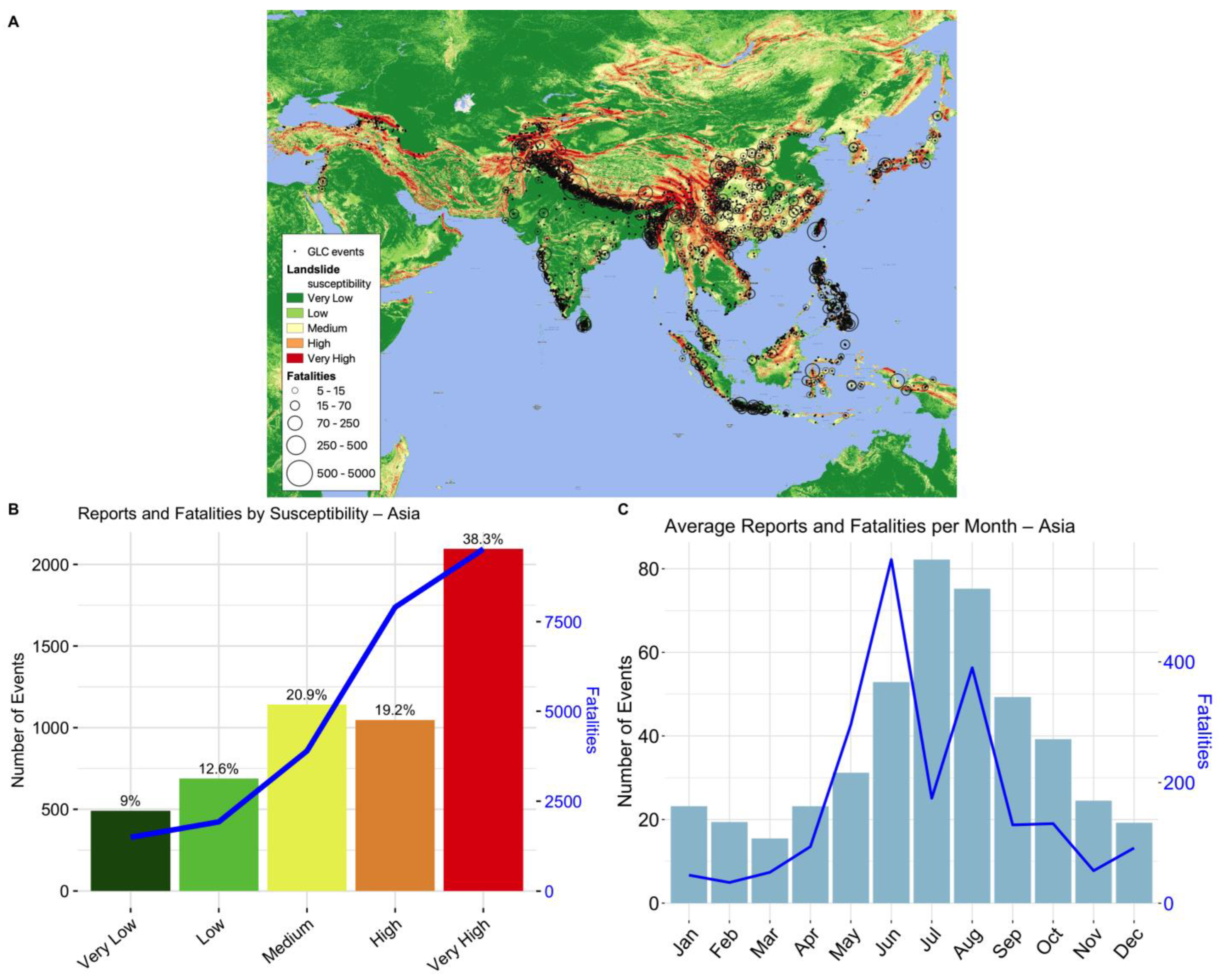
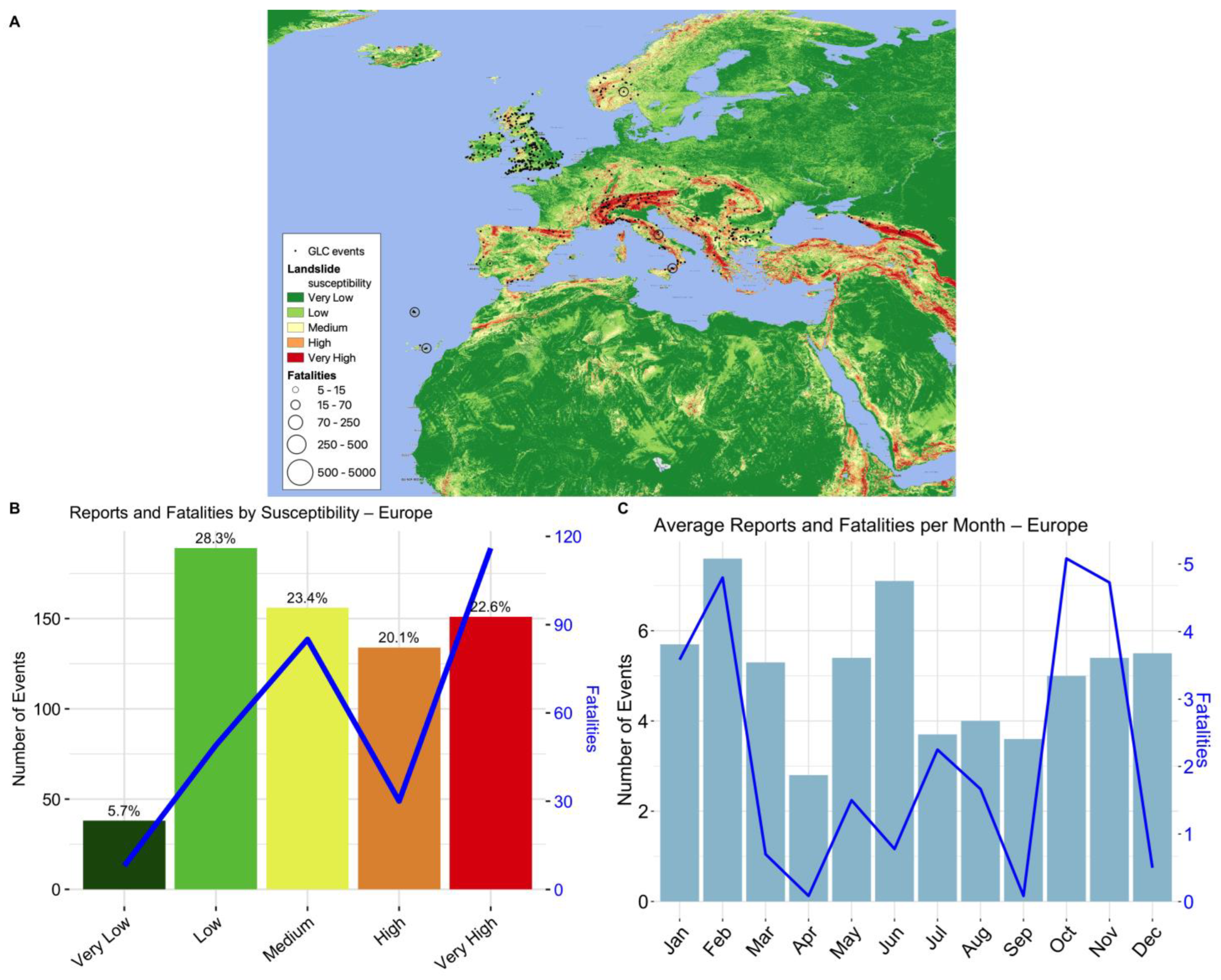



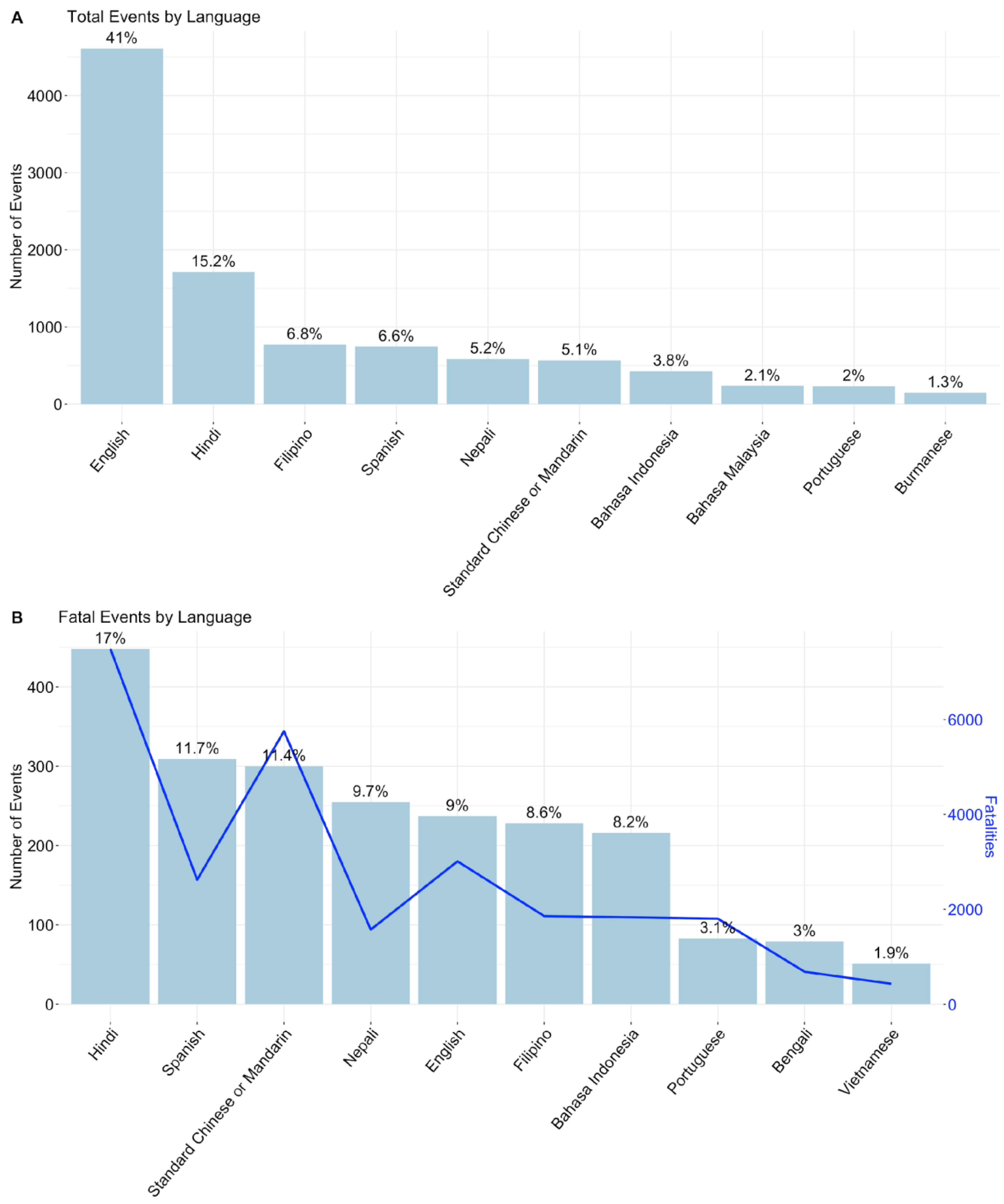


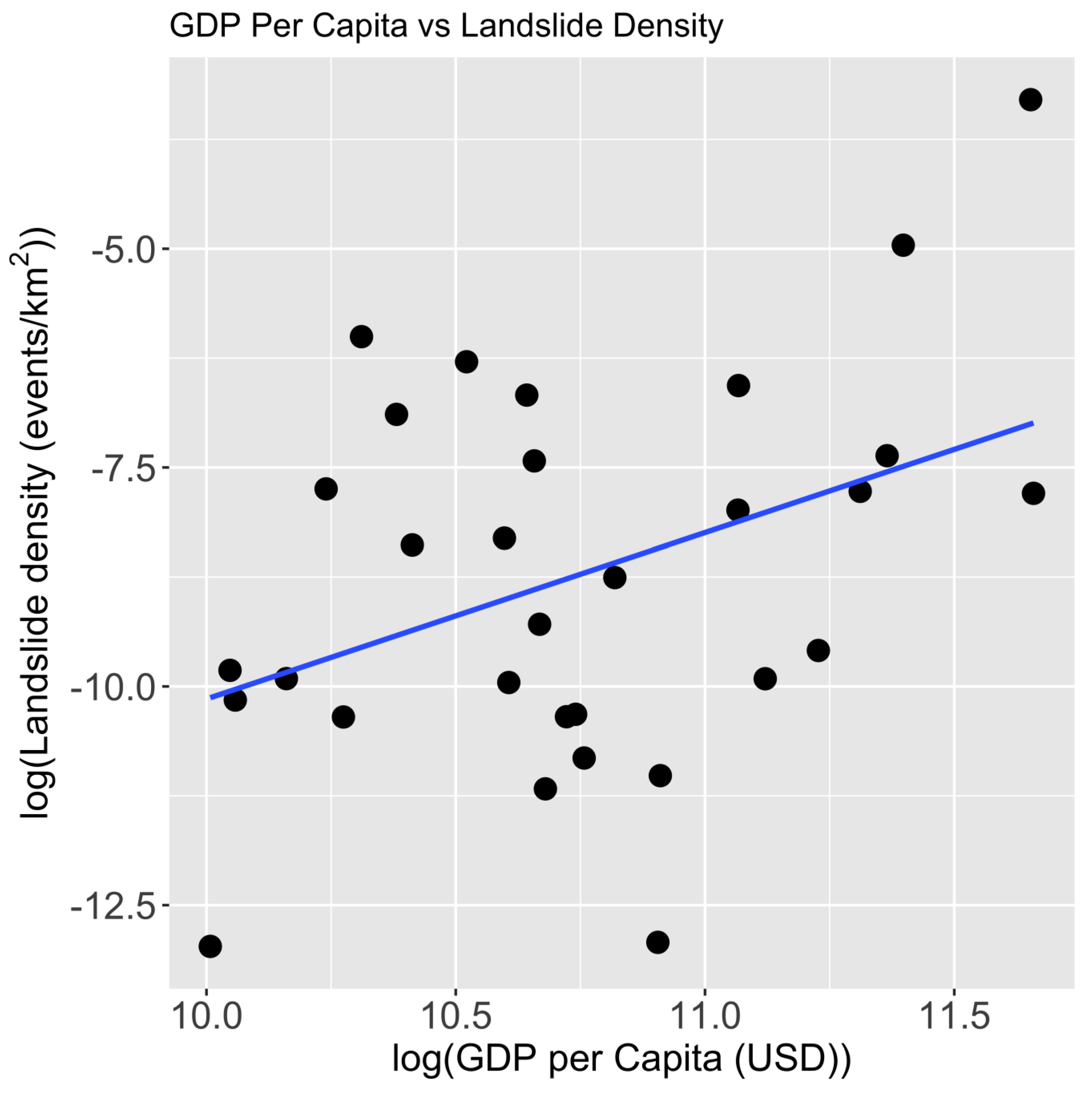
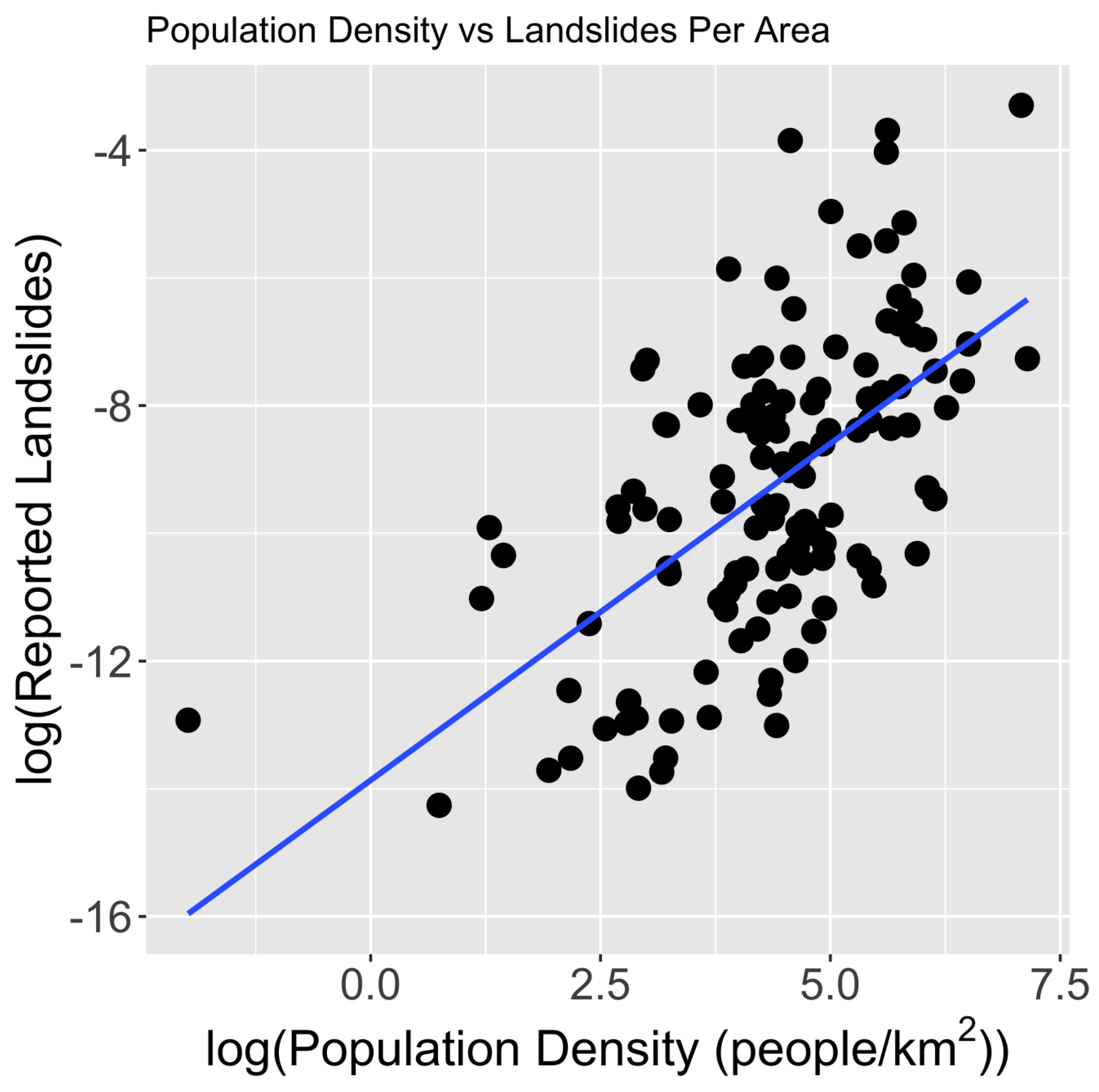
| Name | Description | Source |
|---|---|---|
| Global Landslide Catalog | Global compilation of rainfall-triggered landslides from 2007 to 2018 | [6] |
| Area (km2) | A country’s total area | [32] |
| Population Density (people/km2) | Midyear population divided by land area in square kilometers | [33] |
| GDP per Capita (USD) | Gross Domestic Product (GDP) divided by the midyear population | [34] |
| Landslide Hazard | Global landslide susceptibility map | [5,35] |
| Landslide Inventories | Landslide event inventories from 2008 to 2018 | [3,17,36,37,38] |
| Region-specific landslide inventory for the Apulian region of southern Italy collected from 2008 to 2016 | [39] |
| Location Accuracy | Number of Events | Percentage of Total Events (%) |
|---|---|---|
| Exact | 1386 | 12.7 |
| 1 km | 2185 | 19.8 |
| 5 km | 3178 | 28.8 |
| 10 km | 1435 | 13.0 |
| 25 km | 1470 | 13.3 |
| 50 km | 794 | 7.2 |
| 100 km | 25 | 0.2 |
| 250 km | 16 | 0.1 |
| Unknown | 542 | 4.8 |
| Size | Number of Events | Percentage of Total Events (%) |
|---|---|---|
| Small | 3199 | 28.2 |
| Medium | 6880 | 60.7 |
| Large | 900 | 7.9 |
| Very large | 118 | 1.0 |
| Catastrophic | 8 | 0.1 |
| Unknown | 229 | 2.0 |
| Triggering Mechanism | Number of Events | Percentage of Total Events (%) |
|---|---|---|
| downpour | 4836 | 42.68 |
| rain | 2874 | 25.37 |
| unknown | 1174 | 10.36 |
| continuous rain | 839 | 7.41 |
| tropical cyclone | 601 | 5.30 |
| monsoon | 245 | 2.16 |
| snowfall snowmelt | 155 | 1.37 |
| mining | 117 | 1.03 |
| construction | 102 | 0.90 |
| earthquake | 99 | 0.87 |
| flooding | 92 | 0.81 |
| no apparent trigger | 73 | 0.64 |
| freeze–thaw | 41 | 0.36 |
| other | 41 | 0.36 |
| dam embankment collapse | 19 | 0.17 |
| Leaking pipe | 17 | 0.15 |
| volcano | 4 | 0.04 |
| vibration | 1 | 0.01 |
| Location | Number of Points | Rainfall Event Date | Points in GLC | Size | Location Accuracy | Source |
|---|---|---|---|---|---|---|
| Khao Phanom, Thailand | 225 | 30 March 2011 | 2 | Large (1) | 5 km (2) | [17] |
| Medium (1) | ||||||
| Falam, Myanmar | 5086 | 30–31 July 2015 | 1 | Medium | 5 km | [17] |
| Hakha, Myanmar | 1737 | 30–31 July 2015 | 1 | Small | 5 km | [17] |
| Thaphabath, Laos | 242 | 11 September 2015 | 0 | [17] | ||
| Mu Chang Chai, Vietnam | 1256 | 2–3 August 2017 | 0 | [17] | ||
| Muong La, Vietnam | 758 | 2–3 August 2017 | 0 | [17] | ||
| Bat Xat, Vietnam | 99 | 23–28 August 2017 | 1 | Large | 25 km | [17] |
| Da Bac, Vietnam | 1086 | 10–11 October 2017 | 1 | Large | 5 km | [17] |
| Phu Yen, Vietnam | 1368 | 10–11 October 2017 | 0 | [17] | ||
| Tram Tau, Vietnam | 1490 | 10–11 October 2017 | 0 | [17] | ||
| Sin Ho, Vietnam | 707 | 23–24 June 2018 | 0 | [17] | ||
| Tam Duong, Vietnam | 159 | 23–24 June 2018 | 0 | [17] | ||
| Than Uyen, Vietnam | 312 | 23–24 June 2018 | 0 | [17] | ||
| Vi Xuyen, Vietnam | 157 | 23–24 June 2018 | 0 | [17] | ||
| Hpa-An, Myanmar | 992 | 28–30 July 2018 | 0 | [17] | ||
| Phong Tho, Vietnam | 302 | 3 August 2018 | 0 | [17] | ||
| Xieng Ngeun, Laos | 1178 | 30 August 2018 | 0 | [17] | ||
| Muong Lat, Vietnam | 1718 | 27 August–1 September 2018 | 0 | [17] | ||
| Nha Trang, Vietnam | 207 | 18 November 2018 | 1 | Medium | 5 km | [17] |
| Blumenau, Brazil | 597 | 20–25 November 2008 | 0 | [18] | ||
| Teresópolis, Brazil | 7268 | 11–13 January 2011 | 16 | Medium (8) | 1 km (1) | [18] |
| Large (4) | 5 km (9) | |||||
| Very Large (4) | 10 km (6) | |||||
| Salgar, Colombia | 131 | 17–18 May 2015 | 0 | [18] | ||
| Dominica | 1756 | 25–28 August 2015 | 1 | Large | 5 km | [38] |
| Dominica | 21,379 | 18–22 September 2017 | 0 | [38] | ||
| Kii Province, Japan | 1901 | 2–5 September 2011 | 0 | [18] | ||
| South Taiwan | 429 | 15–18 July 2008 | 1 | Medium | 10 km | [18,37] |
| Taiwan | 10,236 | 6–9 August 2008 | 0 | [18,36,37] |
Disclaimer/Publisher’s Note: The statements, opinions and data contained in all publications are solely those of the individual author(s) and contributor(s) and not of MDPI and/or the editor(s). MDPI and/or the editor(s) disclaim responsibility for any injury to people or property resulting from any ideas, methods, instructions or products referred to in the content. |
© 2023 by the authors. Licensee MDPI, Basel, Switzerland. This article is an open access article distributed under the terms and conditions of the Creative Commons Attribution (CC BY) license (https://creativecommons.org/licenses/by/4.0/).
Share and Cite
Dandridge, C.; Stanley, T.A.; Kirschbaum, D.B.; Lakshmi, V. Spatial and Temporal Analysis of Global Landslide Reporting Using a Decade of the Global Landslide Catalog. Sustainability 2023, 15, 3323. https://doi.org/10.3390/su15043323
Dandridge C, Stanley TA, Kirschbaum DB, Lakshmi V. Spatial and Temporal Analysis of Global Landslide Reporting Using a Decade of the Global Landslide Catalog. Sustainability. 2023; 15(4):3323. https://doi.org/10.3390/su15043323
Chicago/Turabian StyleDandridge, Chelsea, Thomas A. Stanley, Dalia B. Kirschbaum, and Venkataraman Lakshmi. 2023. "Spatial and Temporal Analysis of Global Landslide Reporting Using a Decade of the Global Landslide Catalog" Sustainability 15, no. 4: 3323. https://doi.org/10.3390/su15043323
APA StyleDandridge, C., Stanley, T. A., Kirschbaum, D. B., & Lakshmi, V. (2023). Spatial and Temporal Analysis of Global Landslide Reporting Using a Decade of the Global Landslide Catalog. Sustainability, 15(4), 3323. https://doi.org/10.3390/su15043323







